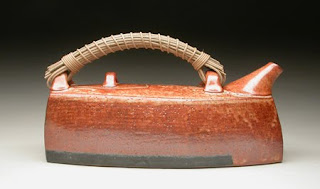
I really like making teapots.
There are so many shapes you can explore.
This is one of my 'lantern' pots. The shape of the body reminds me of old paper lanterns.
The design idea here is to make a pot that has been pared down to the most basic elements of form.
Every teapot has a personality.
A teapot is supposed to be the potter's thesis because of the complexity of aligning many small forms into a single pot for a specific function--the body, foot, lugs, handle, spout, the lid and galley, all must work in harmony to become a good pot.
And of these many elements, many variants must be considered:
The body shape.
The placement of the handle lugs, the placement of the spout.
The lid and galley.
Glazes inside and out
and much, much more.
Will the pot be functional or decorative?
Although most teapots are meant to be used, a teapot can serve as the basis for an art statement .
Pictured are Meryl Ruth's Purse teapots (L.). More of her work can be found on line. It is obvious with this pot that it is not meant to be used for making tea.
My pot on the right is designed to hold two cups of tea plus refills. It is definitely designed for tea.
If the pot is meant to be used, the artist must decide:

The foot: A round, trimmed foot? Legs? A pedestal, attached or a separate one? How about a constructed one?
The body and the brewing of tea: Overall shape: Round, oval, altered, flared at the bottom or top? Concave? Undulating? Grooved, lined or paddled?
Will the pot hold the heat?
What kind of glaze to use inside?
Make a clay strainer or keep the spout clear? Accommodate the use of a tea-ball? I've seen pots with little U-shaped holes in the rim of the lid-seat that will accommodate the string and tab of a teabag.
The lid and the release of steam: Even though the steam hole is traditionally placed in the lid, I have actually seen a pot with a tiny hole concealed in the lid seat. ( The steam hole must also be placed somewhere that will not allow steam to reach the hand that is pouring the tea.)
The action of the lid flange and the seat of the lid during pouring. Does it sit well? Will it have a notch and knob arrangement to keep the lid on when the pot is tipped up? Will the flange have a long bottom that catches on the lid rim and hold the lid?
Make a top knob on the lid or not? How will the knob relate to the rest of the pot? To the fingers?
The relationship between the lid, the lugs and the handle.
The lugs: Are they far enough apart to allow easy access to the lid? Are they in harmony with the overall design of the pot? Should they be? Do they sit up or out or in? Are they a different design/material than the usual lugs? Do you want them to be obvious or to "melt" into the body of the pot? Check out this great handle by Nils Lou.
Or this wonderful pot by Stephen Hill.
The spout: Large or small? Is the angle right? Does it dribble? What about the finish of the end of the spout? Rounded? A sharp, flat cut? Is the tip high enough to keep the tea concentrated at the spout and not leak from the lid when the tea is poured?
How the pot functions and handles: Is it too light or too heavy? Does it have a balance when you use it? Does it "feel" right when you pick it up and pour? Does it work on a purely functional level--is it really a working teapot? Does that matter? For instance, you can look at this one by Mel Jacobson and just know it will work well.
The consideration of additional forms to accompany the main form of a teapot such as a tray, creamer and sugar, mugs or cups. (I wish I knew who made this snuggley grouping of a pot, creamer and sugar.)
Or this great assemblage by Matt Wilt.

And here's a great pairing of a pot and cups by Diana Angel-Wing.
What firing method will be chosen? Wood or electric? Raku, reduced or oxidized?
What kind of finish for the outside? Glazed or burnished, poured or dipped, brushed or sprayed, carved or applied, printed or any other treatment?
And finally, after all these decisions and executions, the big question:
And does it work aesthetically? Is it an artistically pleasing unit?
Does it answer the questions of the eye?
Take a look at this absolute symphony of a teapot made by my friend Gail Bair. It's a virtual juggling act of many strong elements and skills melded into a wonderful balance and strong statement that happens to be a teapot. She does more of these and other great work.
You can see more of her work on www.claybair.com.

Look at this wonderful sculpture by Lisa Qualls from The Texas Teapot Tournament website www.cameohouston.org/pages/events/teapot.html
The 2010 show should be up soon. (previous shows in the gallery)
Sequoia Miller makes great teapots: www.sequoiamillerpottery.com
As does Ann Hirondale:

This rather large pot on the left is surprisingly lightweight. Check out her amazing new work by googling her name.


There are lots of books on teapots and of course, the wonderful 500 series from Lark Publications of 500 Teapots.
The web is loaded with images of teapots.
Check out a blog devoted exclusively to teapots at: www.teapotsteapotsteapots.blogspot.com.
And for a really great tour of teapots and more, check out www.flickr.com/people/gusstiffpottery.
Or see www. strecker -nelsongallery.com/Artists_nu/Teapot/teapotSlideShow/index.htm, includes one of my favorite makers, Yokhi Ikeda.
The last 3 years of the Strictly Functional annual show,including teapots can be seen at www.art-craftpa.com/exhibit.html,






























